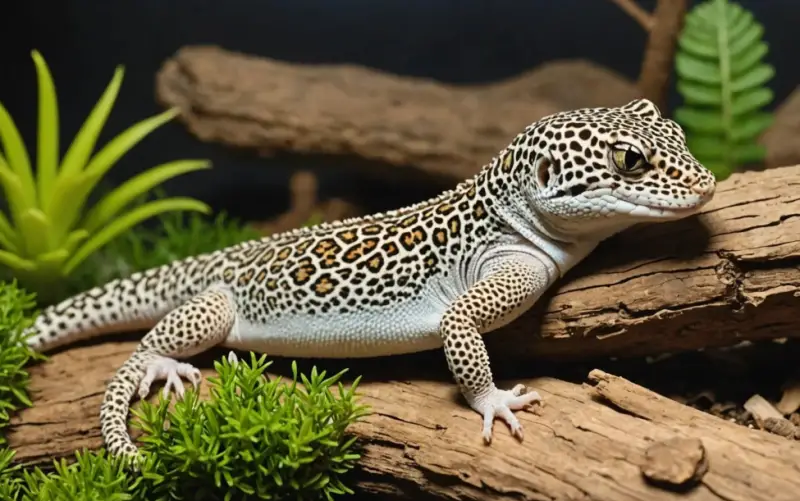Leopard geckos are fascinating reptiles, loved by many pet owners for their docile temperament and beautiful patterns. These nocturnal creatures are native to the arid deserts of Afghanistan, Pakistan, and India, and their natural habitat is vastly different from the typical home environment. To ensure your leopard gecko remains healthy and happy, it is essential to replicate these conditions in its habitat.
In this comprehensive guide, we will cover the critical elements that make up the ideal living conditions for your leopard gecko, including temperature, humidity, substrate, lighting, and more. We will dive deep into the specifics of creating an environment that will help your gecko thrive.
What Makes the Ideal Leopard Gecko Habitat?

The key to creating the perfect habitat for your leopard gecko is to replicate the conditions it would experience in the wild. These geckos are adapted to an environment with stable temperatures, low humidity, and natural hiding spots. A leopard gecko’s habitat should offer a variety of temperature zones, places to hide, and a safe, clean environment for it to thrive. Let’s take a closer look at the individual components that make up this habitat.
1. Temperature: The Key to a Healthy Habitat
Temperature plays a pivotal role in the health of your leopard gecko. Being cold-blooded, they depend on external sources to regulate their body heat. The temperature inside their tank must reflect the natural temperature gradient they would encounter in the wild, allowing them to regulate their body temperature by moving between hot and cool areas.
Hot Spot vs. Cool Zone
To create an effective temperature gradient, divide the tank into two sections: a hot spot and a cool zone. The hot spot provides the heat your gecko needs for digestion and metabolism, while the cool zone allows it to escape the heat and cool down when needed. This variation in temperature will help your gecko to stay comfortable and regulate its body temperature effectively.
- Hot Spot: The hot spot in the enclosure should range between 90°F and 95°F (32°C – 35°C). You can use various heating methods to achieve this, such as heat mats, heat lamps, or ceramic heat emitters. Place the heat source on one side of the tank to ensure there is a temperature gradient across the enclosure. The hot spot should be located on one side of the tank so that your gecko can move between the warm and cooler areas depending on its needs.
- Cool Zone: On the other side of the tank, create a cool zone where the temperature ranges from 75°F to 80°F (24°C – 27°C). The cool zone provides your gecko with an area to retreat to when it gets too warm in the basking spot. This will help prevent your gecko from overheating and ensure it has a temperature range in which it can thrive.
Nighttime Temperature
Leopard geckos experience temperature fluctuations in their natural environment, including cooler nights. At night, the temperature in their habitat should drop to around 65°F to 70°F (18°C – 21°C). This temperature drop mimics the natural cooling process that occurs in the desert during the night. Nighttime temperatures that are too high can disrupt your gecko’s natural rhythms and cause stress.
It is important to avoid drastic temperature fluctuations within the enclosure. Use thermostats to monitor and maintain the temperature levels to avoid extremes, as sudden changes can negatively impact your gecko’s health.
2. Humidity: How to Maintain the Right Level
Humidity is another important factor to consider when setting up a leopard gecko habitat. In the wild, leopard geckos live in areas with very low humidity levels, and their bodies are adapted to dry conditions. They do not require high humidity to survive, and excessive moisture can lead to health issues such as respiratory problems or fungal infections.
Ideal Humidity Levels
Maintaining a humidity level between 30% and 40% is ideal for a leopard gecko habitat. Too much moisture in the air can cause your gecko to develop skin issues, respiratory problems, or mold in the tank. On the other hand, humidity that is too low can lead to dehydration and difficulty shedding.
To measure the humidity in the tank, use a hygrometer, which can be purchased from pet stores or online. Place it in the center of the tank for an accurate reading of the ambient humidity. If you find that the humidity is too high, reduce misting or airflow, and make sure that water dishes are not too large.
Managing Humidity with a Moist Hide
While leopard geckos do not require a highly humid environment, they need higher humidity levels during shedding. A moist hide can help with this by providing a humid microenvironment where the gecko can go to shed its skin comfortably. The moist hide should contain a damp paper towel or sphagnum moss to create the right amount of moisture.
Moist hides are essential for the shedding process, as they help to soften the old skin, making it easier for the gecko to shed. Without proper humidity, your leopard gecko may experience difficulty shedding, which can lead to retained shed skin, causing skin infections or other complications.
3. Substrate: Choosing the Best Bedding
Substrate, or bedding, is the material that lines the bottom of your leopard gecko’s enclosure. The right substrate plays a key role in maintaining a clean and comfortable environment for your pet. Choosing the wrong substrate can lead to health issues, so it is important to choose a safe and appropriate option for your gecko.
Safe Substrates
There are several safe substrate options for leopard geckos that you can choose from. These include:
- Reptile Carpet: This is a popular and safe choice for leopard geckos. It is made from a durable material that can be easily cleaned and reused. Reptile carpet provides a smooth surface that is comfortable for your gecko to walk on, and it prevents the risk of ingestion that comes with loose substrates.
- Paper Towels: Paper towels are an affordable and easy-to-replace option for substrate. They are also very hygienic and can be swapped out easily if there are any accidents or spills. However, they don’t provide much of a natural look or texture.
- Tile: Ceramic or slate tiles make excellent substrates for leopard geckos. They are durable, easy to clean, and provide a stable surface for your gecko to walk on. Tiles also help regulate temperature and humidity, making them a great choice for reptile enclosures.
- Carpeted Mat: Like reptile carpet, carpeted mats provide a safe and comfortable surface for your gecko. These mats are easy to clean and offer a non-abrasive surface that is gentle on your gecko’s skin.
Substrates to Avoid
While some substrates may seem suitable, they can actually pose a risk to your leopard gecko. Here are a few substrates you should avoid:
- Sand: While sand may look natural, it can be harmful if ingested. Leopard geckos have a tendency to lick or ingest substrate while foraging or exploring, and sand can lead to serious digestive issues such as impaction, which can be fatal.
- Cedar or Pine Shavings: Cedar and pine contain oils that are toxic to reptiles and should never be used as substrate. These oils can cause respiratory issues and irritation to your gecko’s skin.
4. Hides: Providing Security and Comfort
Leopard geckos are shy creatures and need plenty of hiding spots to feel secure. In the wild, they spend much of their time in burrows or under rocks. In captivity, they need multiple hides in their enclosure to feel safe and secure.
Types of Hides
- Moist Hide: A moist hide is essential during shedding. It creates a high-humidity environment where your gecko can shed its skin comfortably. You can create a moist hide by placing damp sphagnum moss or paper towels inside a small container with a hole for entry. This hide should be placed in the warm zone to provide optimal conditions for shedding.
- Dry Hide: A dry hide should be placed in the cool zone of the tank. This provides your gecko with a cool, dry area to retreat to when it wants to rest or sleep.
- Multiple Hides: Ideally, you should provide your leopard gecko with at least two hides: one in the warm zone and one in the cool zone. This allows the gecko to choose its hide based on its temperature preference.
5. Lighting: Natural Day-Night Cycle
Leopard geckos are nocturnal and do not require UVB lighting, unlike many other reptiles. However, a regular light cycle helps simulate the natural day-night rhythm, which is essential for your gecko’s circadian rhythm.
Light Cycle
- Daytime: Your leopard gecko should have 10 to 12 hours of light during the day to mimic natural sunlight. You can use a regular fluorescent bulb or an LED light to provide daytime illumination.
- Nighttime: At night, the light should be turned off. If you want to observe your gecko during the night without disturbing its sleep cycle, use a low-wattage red or blue bulb. These lights are low-intensity and will not interfere with your gecko’s natural sleep patterns.
6. Size of the Enclosure
The size of your leopard gecko’s enclosure depends on its age and size. It is essential to provide your gecko with enough space to roam, explore, and hide. A cramped tank can lead to stress and a lack of stimulation.
- Young Geckos: For baby and juvenile leopard geckos, a 10-20 gallon tank should be sufficient. This gives them enough space to move around while being small enough to feel secure.
- Adult Geckos: Adult leopard geckos need a larger tank, typically 40-50 gallons. A larger tank allows you to create the proper temperature gradient and gives your gecko ample room to roam and explore.
7. Accessories: Adding Enrichment to the Habitat
To encourage natural behaviors and enrich your leopard gecko’s life, consider adding accessories to its habitat.
Climbing and Hiding Structures
- Rocks and Logs: Leopard geckos enjoy climbing and exploring their environment. Adding rocks, logs, or branches can provide stimulation and help mimic the natural environment.
- Plants: Artificial plants add a natural touch to the habitat. However, avoid using live plants since leopard geckos may nibble on them.
8. Cleaning and Maintenance
Regular cleaning is essential to maintain a healthy environment for your gecko. A dirty tank can lead to bacterial growth and health problems for your pet.
- Weekly Cleaning: Clean the water dish, remove feces, and spot clean the substrate to prevent waste buildup.
- Monthly Cleaning: Do a thorough cleaning by removing all items from the tank, washing the tank, and replacing the substrate.
Conclusion
Creating the ideal leopard gecko habitat requires attention to detail, from temperature and humidity to substrate and hiding spots. By replicating their natural environment as closely as possible, you can ensure your gecko will lead a healthy, happy life. Proper care and an optimal habitat are essential for the well-being of your pet, so take the time to set up an environment that meets all of their needs.






